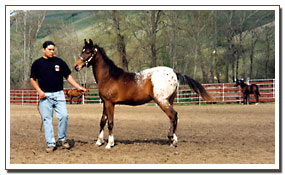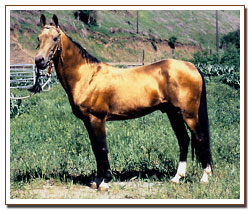
Economic stability important to Nez Perce
Nez Perce Wolf Recovery has friends and foes
Tribal ethnographer passes on heritage
to younger generation
Memorandum tries to strengthen university
and tribal ties
Redtail Singers: Songs can lift a person's heart
| By
Morgan Winsor
A new breed of horse roams the Nez Perce reservation.
|
In 1994, Shebala spearheaded the Horse Registry program to raise a new breed of horse called the "Nez Perce." "We (the Nez Perce Tribe) wanted a horse similar to the type of horse that was lost a hundred years ago," Shebala said. Shebala, a Navajo who married a Nez Perce 18 years ago, said the Tribe chose to breed the Appaloosa with the akhal-teke because "it has a much thinner and taller frame compared to the appaloosa." Akhal-teke horses come from the dry, sun-drenched desert of the former Soviet Republic of Turkmenistan. They have thinner skin due to consistent heat and were raised to run at top speed non-stop for long periods at a time. "The Akhal-teke are more greyhound-like," Shebala said. "They are known to run 120 miles a day up to 10 days in a row." Shebala said introducing the breed has already sparked the Tribe’s interest to learn the art of horsemanship. "For quite a few years horsemanship was suppressed," Shebala said. "It’s back." Late last year Shebala sold a Nez Perce mare for $14,500. "And currently I am negotiating another sale of a mare for $6,500," he said, adding that all proceeds from horse sales go back into the program. Shebala said the only drawback to the program is selling the best horses to improve the reputation of the Horse Registry. "But we’ll continue to breed and sell the best horses to prove to our Tribal Council and tribal members that the program is a success," he added. Shebala envisions that 10 years from now, the Nez Perce horse "will be at top competitions and the Nez Perce Tribe, once again, will be famous for historically developing a superior horse." |
||||||||
|
|||||||||

